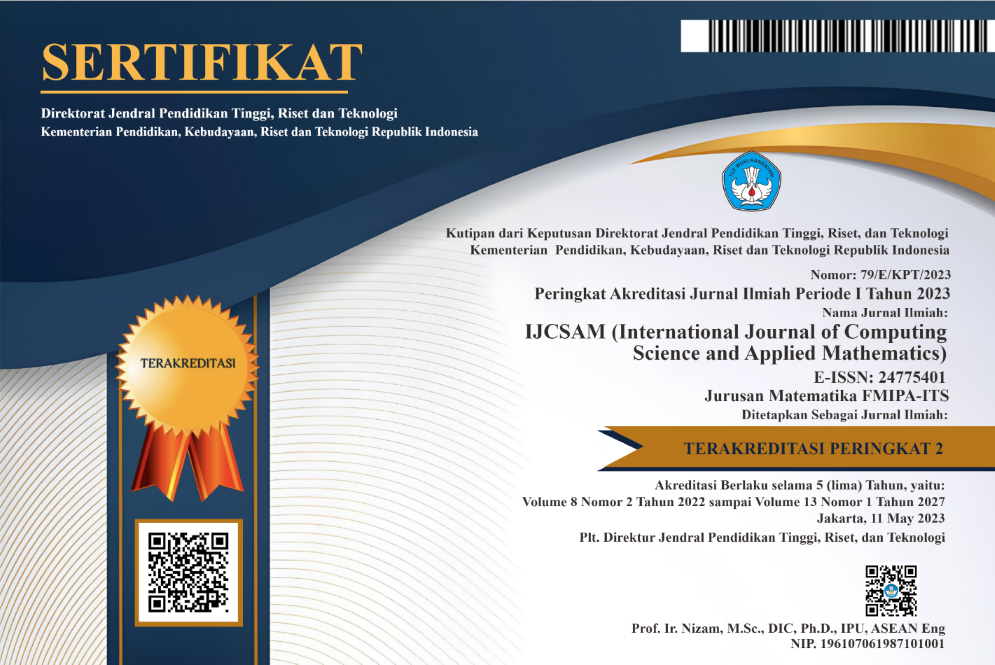Optimal Control of the Spread of Dengue Fever by Controlling the Vectors Growth Affected by Climate Change and Treatment
Abstract
Dengue Hemorrhagic Fever (DHF) is an infectious disease caused by the dengue virus and is spread through the bite of an adult female Aedes aegypti mosquito, as a vector (disease-carrying animal), to humans. This disease is still a major health problem in tropical and subtropical regions. Indonesia is reported as the 2nd highest country among 30 other endemic countries. Warm temperatures during the rainy season are ideal conditions for mosquitoes to lay eggs optimally, increasing egg maturity, and shortening the virus incubation period. This has an impact on increasing the number of mosquitoes and the risk of disease transmission. In this study, control of DHF was carried out by controlling the growth of vectors in the egg and adult phases of mosquitoes, which were influenced by rainfall and air temperature, as well as the treatment of infected humans. Before carrying out the control, stability analysis around the equilibrium point is first conducted. Next, the numerical solution is obtained using the Runge-Kutta method of order 4 with the help of MATLAB software. The results of the analysis show that, based on the optimal control effect in the form of mosquito egg death (k1), adult mosquito death (k2), and human treatment (k3), in the cities of Pekanbaru and Solok, there is not much difference between the two. However, there is a slight difference in the increase in the human population that is susceptible to disease.
Full Text:
PDFReferences
S. Soekiman, Demam berdarah dengue-dengue haemorrhagic fever, Sagung Seto, Jakarta, 2012.
Kementerian Kesehatan RI, ”Demam berdarah dengue,” Buletin Jendela Epidemiologi, 2010. [Online]. Available: http://example-link1.com
M. Rossi, L. Lopez, and E. Massad, “The dynamics of temperatureand rainfall-dependent dengue transmission in tropical regions,” Annals of Biometrics & Biostatistics, vol. 2, no. 2, pp. 1–6, 2015. [Online]. Available: http://example-link2.com
A. Bustamam, D. Aldila, and A. Yuwanda, “Understanding dengue control for short-and long-term intervention with a mathematical model approach,” Journal of Applied Mathematics, vol. 2018, p. 100120, 2018. [Online]. Available: https://doi.org/10.1016/j.sintl.2021.100120
W. Wartono, M. Soleh, and Y. Muda, “Mathematical model of dengue control with control of mosquito larvae and mosquito affected by climate change,” BAREKENG: Jurnal Ilmu Matematika dan Terapan, vol. 15, no. 3, pp. 417–426, Sep. 2021. [Online]. Available: http://example-link3.com
J. E. Kim, Y. Choi, J. S. Kim, S. Lee, and C. H. Lee, “A two-patch mathematical model for temperature-dependent dengue transmission dynamics,” Processes, vol. 8, no. 7, p. 781, 2020. [Online]. Available: http://example-link4.com
DOI: http://dx.doi.org/10.12962%2Fj24775401.v10i2.21951
Refbacks
- There are currently no refbacks.
View My Stats

International Journal of Computing Science and Applied Mathematics by Pusat Publikasi Ilmiah LPPM, Institut Teknologi Sepuluh Nopember is licensed under a Creative Commons Attribution-ShareAlike 4.0 International License.
Based on a work at https://iptek.its.ac.id/index.php/ijcsam.






